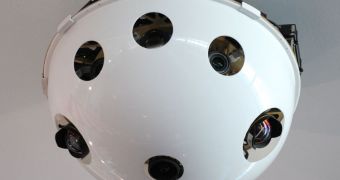Experts from the US Department of Homeland Security (DHS) Science and Technology Directorate (S&T) announce the development of a new type of surveillance system. The Imaging System for Immersive Surveillance (ISIS) represents a new approach to conducting scans of crowds, officials from the S&T say. The device containing the new system is round, and features multiple objectives, which are used as a single viewing source. This means that the image ISIS produces is actually a quilt of several high-resolution cameras. The end result is a very wide-angle, fisheye-like view that carried exquisite details from edge-to-edge.
One of the disadvantages of fisheye lenses is that they distort the image, and thus carry very little detailed data. The areas around the edges are generally difficult to zoom into, and provided blurry and fuzzy views. But ISIS is different because it can easily zoom into any corners. The view is clear and with detail to spare, thanks to the fact that edges of the overall image are actually captured through high-resolution, stand-alone cameras. As such, surveillance experts can now zoom in on a region of the live video stream, without losing coverage of the wide-field as a whole.
“Coverage this sweeping, with detail this fine, requires a very high pixel count. ISIS has a resolution capability of 100 megapixels.” explains the S&T’s Infrastructure and Geophysical Division program manager, Dr John Fortune. He adds that this is the same level of detail as no less than 50 HDTV sets playing at the same time, and all of it coming from a single ISIS. The original technologies that were modified in order to create the new system were developed for military applications by researchers at the Massachusetts Institute of Technology (MIT) Lincoln Laboratory.
The expert underlines that fact that, unlike image stitching software currently available, the ISIS is capable of producing live video streams, which means that an objective can be surveyed at this incredible resolution in real time. “We’ve seen that terrorists are determined to do us harm, and ISIS is a great example of one way we can improve our security by leveraging our strengths,” Fortune adds. The system was developed by experts at Lincoln Lab, in collaboration with colleagues from the US Department of Energy's (DOE) Pacific Northwest National Laboratory (PNNL).

 14 DAY TRIAL //
14 DAY TRIAL //